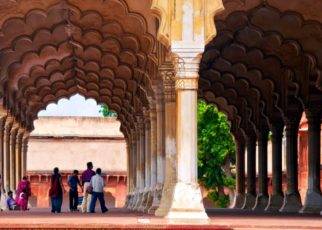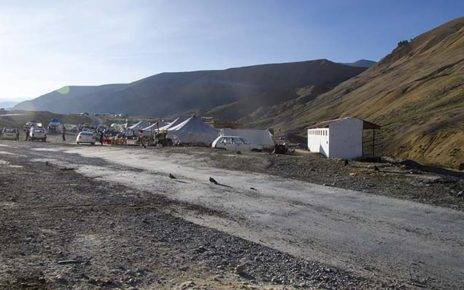Akbar the Great ascended the throne of the Mughal Empire in Delhi on the death of his father when he was 13 years old in 1556. Akbar’s formal name was Jalaluddin Muhammad Akbar. He set about consolidating his empire and in 1570 began construction of the sandstone mosque and palace at Fatehpur Sikri with the prefix “Fatehpur” (meaning “victory”) added after the battle of Gujerat in 1573. The site was chosen as his capital city after the mystic Sheikh Salim of Sikri, prophesied that Akbar would have three sons. Subsequently, when Akbar’s first two sons were born, he built the palace complex at Sikri near Agra that would become the Mughal capital in 1571. In fact, the first major structure at the site was the congregational mosque, the largest in India at that time at 130 meters by 160 meters (Andersen, 1996). Fatehpur Sikri would remain the capital until 1585.
Architecture
The mosque and palace is built almost entirely of red sandstone with the exception of Sheikh Salim’s tomb which is constructed of marble. The palace complex is located in the state of Uttar Pradesh in northern India and is a UNESCO World Heritage Site. One notable aspect of Akbar’s reign is that he sought coexistence between the Hindu and Muslim traditions. This is reflected in the palace at Fatehpur Sikri; though Akbar was a Mughal emperor of the Muslim tradition, the Panch Mahal in the palace complex included no Islamic arches or domes.
Notable features of the group of buildings include Diwan-i-Am, the Hall of Public Audiences. From a throne here, Akbar and his ministers heard petitions and dispensed justice. In the Hall of Private Audiences, the Diwan-i-Khas, the emperor met foreign dignitaries and other honored guests. Here, a throne on a circular balcony supported by brackets atop a pillar is the central feature. In the Diwan-i-Khas, Akbar invited conversation from diverse religious groups and cultivated a period of tolerance and secularism (e.g., Dalrymple, 2004). Buildings at Fatehpur Sikri are influenced by Buddhist, Hindu, and Islamic traditions, and a Christian text is inscribed over the tallest gate to the palace complex (Dalrymple, 2004). The Panch Mahal, inspired by Buddhist architectural traditions (ICOMOS, 1986), served as a kind of pleasure palace high above the city and was designed to catch the wind and thus provide a cooling effect against the heat of the city below for Akbar and his queens and princesses. Each story of the Panch Mahal is successively smaller than the one below, with 84 columns on the ground floor. The mosque, described earlier, at Fatehpur Sikri could accommodate approximately 10,000 people.
Growth of the Region
Akbar and his decision to construct a palace and move the capital of his empire to Sikri makes him the most well known of the Mughals associated with Sikri. However, he is not the first Mughal emperor to come to the area. Akbar’s grandfather, Babur, departed from Sikri in 1527 to wage a successful campaign against the Rajput state of Mewar and its ruler, Rana Sangram Singh. At that time, Sikri was considered by Babur’s scouts as a reliable source of water for Babur’s imperial army. After the victory against Mewar, Babur renamed the region Shukri, meaning ‘thanksgiving’ but the name did not stick.
Abandoned City
By 1585, Akbar was compelled to go to Lahore in Pakistan to deal with the death of his half-brother who served as governor in Kabul. Popular stories tell of Akbar’s decision to abandon the city due to a lack of water, and indeed the lake at Fatehpur Sikri is now dried up. However, Brand and Lowry (1985) suggest that this possibility was not indicated by any historians or authors of the time and was only posited later by a 17th century historian. They further suggest that many of Akbar’s harem did remain in Fatehpur Sikri long after 1585, the date often given for the abandonment of the city. In the early 18th century, Sikri was the site for the coronation of Muhammad Shah whose reign ended in 1748.
Tourists, archaeologists, and historians visiting northern India should not miss the opportunity to see this beautiful city and its palace, mosques, and other monuments. The beauty of the architecture, the myths and legends of Akbar, and his legacy of religious tolerance will interest travelers to the Agra district.





